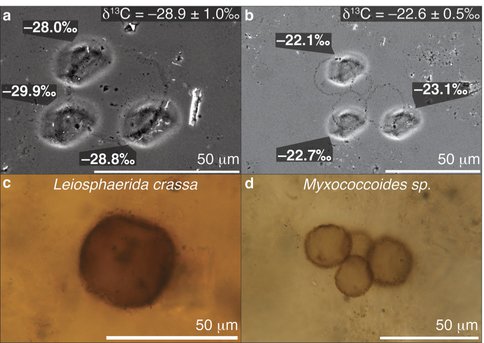2012 Annual Science Report
 University of Wisconsin
Reporting | SEP 2011 – AUG 2012
University of Wisconsin
Reporting | SEP 2011 – AUG 2012
Project 1D: Establishing Biogenicity and Environmental Setting of Precambrian Kerogen and Microfossils
Project Summary
This study demonstrates new abilities to use in situ measurements of carbon isotope ratios in microfossil kerogen as a biosignature and to establish taxonomic and micro-structural correlations.
Project Progress
Prior to the appearance of multicellular, shelled animals at the beginning of the Phanerozoic Eon, the fossil record is composed of unicellular or colonial microbes – rarely preserved, difficult to recognize, commonly morphologically ambiguous, and thus difficult to classify. In the Archean Eon, interpreting the fossil record is even more challenging due to the relatively poor preservation of “possible microfossils” that leads to debates about the biological origin of microbe-like organic structures. We chose four exceptionally preserved Precambrian microfossil communities in order to test whether we could measure the carbon isotopic composition of individual microfossils (and their microanatomical substructures) in situ, and with sufficient precision and accuracy to reveal any taxonomic or microstructural correlations that would provide information about microbial metabolism and be powerful indicators of biogenicity in older, possible microfossils. Using a combination of light and electron microscopy to support SIMS δ13C analysis, we demonstrated for the first time that such taxonomic and microstructural correlations in the carbon isotopic composition of Precambrian microfossils are preserved, and can be detected. One of the highlights of this study was our ability to distinguish, on the basis of their δ13C compositions, a colonial cyanobacterium and a eukaryotic alga preserved less than one centimeter apart in the same sample of ~750 million year old chert.
Backscattered electron (a, b) and transmitted light (c, d) images showing SIMS carbon isotope analyses of Leiosphaerida crassa (a, c) and Myxococcoides sp., microfossils situated ~8 mm apart in the same thin section of the Chichkan Formation stromatolitic chert. The specimen of L. crassa has δ13C consistent with eukaryotic photosynthesis, whereas that of Myxococcoides sp. is consistent with cyanobacterial photosynthesis. Carbon isotopic compositions are given relative to VPDB with precision representing the total range of the three analyses of each specimen (from Williford et al., 2012).
Publications
-
Lepot, K., Williford, K. H., Ushikubo, T., Sugitani, K., Mimura, K., Spicuzza, M. J., & Valley, J. W. (2013). Texture-specific isotopic compositions in 3.4Gyr old organic matter support selective preservation in cell-like structures. Geochimica et Cosmochimica Acta, 112, 66–86. doi:10.1016/j.gca.2013.03.004
-
Williford, K. H., Ushikubo, T., Schopf, J. W., Lepot, K., Kitajima, K., & Valley, J. W. (2013). Preservation and detection of microstructural and taxonomic correlations in the carbon isotopic compositions of individual Precambrian microfossils. Geochimica et Cosmochimica Acta, 104, 165–182. doi:10.1016/j.gca.2012.11.005
- Van Kranendonk, M.J., Schopf, J.W., Williford, K., Grice, K., Pages, A., Kudryavtsev, A.B., Gallardo, V.A., Espinoza, C., Ushikubo, T., Kitajima, K., Lepland, A., Walter, M.R., Yamaguchi, K.E., Hegner, E., Ikehara, M., MacAlady, J., Melendez, I., Flannery, D. & Valley, J.W. (2012). A non-photosynthetic microfossil assemblage dating from the rise of atmospheric oxygen. In revision. Nature.
- Williford, K.H., Ushikubo, T., Lepot, K., Hallman, C., Spicuzza, M.J., Eigenbrode, J.L., Summons, R.E. & Valley, J.W. (2011). In situ carbon isotope analysis of Archean organic matter. EOS, Transactions of the American Geophysical Union, 92.
-
PROJECT INVESTIGATORS:
-
PROJECT MEMBERS:
Takayuki Ushikubo
Co-Investigator
Jennifer Eigenbrode
Collaborator
James Schopf
Collaborator
Ken Sugitani
Collaborator
Roger Summons
Collaborator
Martin Van Kranendonk
Collaborator
Malcolm Walter
Collaborator
Kouki Kitajima
Postdoc
Kevin LePot
Postdoc
Kenneth Williford
Postdoc
-
RELATED OBJECTIVES:
Objective 2.1
Mars exploration.
Objective 4.1
Earth's early biosphere.
Objective 5.1
Environment-dependent, molecular evolution in microorganisms
Objective 5.2
Co-evolution of microbial communities
Objective 6.1
Effects of environmental changes on microbial ecosystems
Objective 7.1
Biosignatures to be sought in Solar System materials

